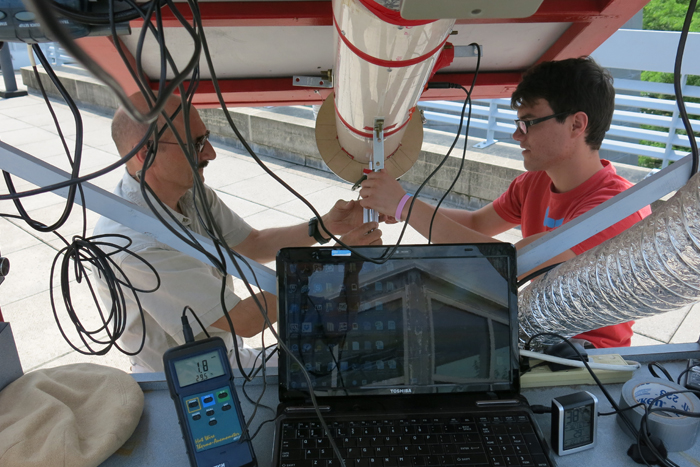Hot Air Rising

Photo by Tony Moore.
Student-faculty summer research focuses on sustainable heating system
by Ben West '14
Research at Dickinson doesn’t just illuminate new paths of knowledge. It also brings to light the productive partnerships and culture of collaboration integral to a Dickinson education. In the case of Associate Professor of Physics & Astronomy Hans Pfister and Tyler Ralston ’15’s work on a solar air heater (SAH), their results reflect both years of dedicated student work and promise to show new paths for sustainability.
“A big box of hot air” is how Ralston, a physics and mathematics double major, describes the SAH. The mosaic of parts and instrumentation on display masks an elegantly simple design: A small fan pushes air through a maze of black absorbing grids behind a glazing, heating the air and passing it through tubing to the space to be heated.
“To illustrate our SAH's efficiency,” says Pfister, “a PV [photovoltaic] panel converts about 17 percent of the incident solar energy into electricity. In contrast to that, we have a solar-to-thermal conversion efficiency of almost 80 percent.”
This summer, Ralston and Pfister are trying to find the SAH’s Goldilocks zone—the point where the air moves fast enough to pick up enough heat without wasting any, but slow enough that the fan doesn’t use too much power.
The SAH in its current form—mounted on a mobile rigging on the roof of Tome Hall and adjustable for an optimal angle to the sun—represents the combined efforts of several students and Dickinson staff. Beyond Ralston and Pfister, Sung Woo Kim ’13 and Andrea Pappas ’13 assisted Rick Lindsey, academic department technician, in its initial construction; Department of Physics & Astronomy technician Jon Barrick rebuilt the original design of the SAH and made it watertight; and Elias Blumenthal ’14, Kylie Logan ’14 and Benjamin Kimock ’15 performed some of the preliminary measurements.
As an aggregation of different students’ and faculty members' work, the SAH resembles other work happening this summer, including the Dickinson College Farm’s GIS project and migrant-student education projects in Adams County.
The resemblance is there in the relationship too: The duo’s work has not just been fruitful but enjoyable as well. “It’s a delight to do the research with him, to bounce ideas off of each other,” says Pfister. “It’s far more interesting than doing research all by yourself.”
Ralston, who is also Pfister’s advisee, agrees. “We would just spitball ideas off each other. And we probably came up with five or six different experiments that we could do, just in talking to each other for a few minutes. The hands-on research experience is a lot more exciting than working on equations all the time.”
Learn more
Published July 9, 2014